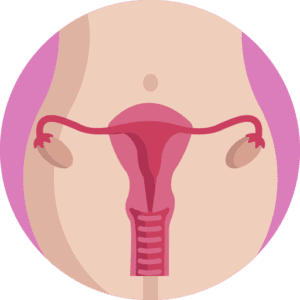The Menstrual Cycle and Psychological Effects
Many women experience mood swings during their period, leading them to wonder about the impact of the menstrual cycle on their psyche. Exploring the relationship between periods and mood is a complex subject that continues to be the focus of ongoing research. This article aims to present the current state of knowledge on the topic.
The Normal Menstrual Cycle
For most women, the menstrual cycle lasts between 25 and 31 days, with an average duration of 28 days.
The female cycle can be divided into two phases, each characterized by different hormonal changes. The first half (days 1-14) is the follicular phase, and the second half (days 14-28) is the luteal phase.
Follicular Phase – 1st Day of Bleeding until Ovulation
The first half of the cycle is when the follicles start to form. These follicles consist of the egg cell and hormone-producing cells around it, which produce estrogen. The high estrogen levels cause the uterine lining to thicken.
Ovulation
Ovulation occurs approximately in the middle of the cycle, triggered by a hormone from the pituitary gland. During this phase, the egg is released from the follicle and travels into the fallopian tube.
Luteal Phase – From Ovulation to the Day before the Next Bleeding.
The remaining follicle now produces progesterone. It helps maintain the endometrial lining and supports the development of specialized cells. If pregnancy does not occur, the progesterone levels drop, leading to the shedding of the uterine lining, which results in menstruation.
The cycle then begins again.
For more detailed explanations, you can refer to the article on the menstrual cycle.
The Menstrual Cycle and Psychological Effects
The relationship between the menstrual cycle and mood has been a topic of interest for researchers, but the findings are not entirely consistent.
One extensive study examined health app data from 3.3 million women in 109 countries. Interestingly, the menstrual cycle showed the most significant impact on mood, behavior, and physical well-being when compared to other cycles like days, weeks, and seasons [1]. During the premenstrual phase, women reported a slightly worsened mood. This effect was observed in all countries studied, and interestingly, it increased with age, with a more pronounced effect in women aged 30-35 compared to those aged 15-20.
In a comprehensive review paper, researchers analyzed 47 studies on the topic. The results were diverse, with 18 (38.3%) of the studies showing no association between mood and the menstrual cycle. 7 (14.9%) of the studies found an association between negative mood and the premenstrual phase. Moreover, 4 (8.5%) studies indicated an association between negative mood and other cycle phases. Interestingly, 18 (38.3%) of the studies revealed an association between negative mood and multiple cycle phases. This indicates that strong evidence for a significant general influence of the premenstrual phase on mood remains elusive [2].
The Premenstrual Syndrome (PMS)
In the medical realm, a diagnosis known as premenstrual syndrome (PMS), refers to recurrent psychological and physical symptoms that manifest during the luteal phase of the menstrual cycle and subside with menstruation. It is estimated that approximately 12-40% of menstruating women are affected by PMS [3,4]. These symptoms may encompass mood swings, depressed moods, irritability, or tension. In more severe cases, premenstrual dysphoric disorder (PMDD) can be diagnosed [5]. Additionally, pre-existing psychological symptoms may intensify during the menstrual cycle, a phenomenon known as premenstrual exacerbation (PME). For instance, individuals with depression or anxiety disorders may experience PME, further complicating the emotional challenges they face during this time. Conversely, many psychological disorders are associated with an increased risk of experiencing PMS symptoms.
Amplifying Emotions: The Menstrual Cycle’s Influence on Existing Feelings
Some researchers [6] suggest that the influence of the menstrual cycle on mood may not be universal, but rather prominent in women with hormone sensitivity, such as those experiencing premenstrual syndrome (PMS). Similarly, there is evidence that the menstrual cycle’s impact on mental health may vary, affecting primarily women who are already prone to mental health problems and low mood.
To investigate further, researchers examined the possible connection between anxiety, rumination, and the menstrual cycle’s influence on mood. In a study of 59 women, aspects of mood, including composure, irritability, energy levels, and positive mood, were analyzed throughout the menstrual cycle. The results indicated increased serenity during the luteal and menstrual phases compared to the ovulatory and follicular phases. However, other aspects of mood appeared unaffected by the menstrual cycle. Notably, anxiety and the propensity for rumination played a role. Women prone to anxiety and rumination displayed greater irritability during the menstrual cycle, whereas this was not evident in women with lower anxiety and rumination [7].
Furthermore, a link was established between PMS and frequent episodes of anger [8]. In addition to the emotions themselves, how individuals cope with them could be another significant influencing factor. For example, researchers discovered an interaction between the sex hormones estradiol and progesterone and rumination, as well as negative feelings. Higher levels of estradiol were associated with more rumination. On the other hand, rumination was linked to more negative feelings only in women with low estradiol levels [9].
Influence of Stress on Menstrual Cycle and Mood
Furthermore, a study involving 259 women revealed a significant connection between perceived stress and menstrual cramps. The findings indicated that increased stress levels preceded more severe menstrual cramps in the subsequent cycle, whereas reduced stress was associated with fewer cramps. This association applied to both psychological and physical symptoms [10].
Similarly, another study involving 446 women identified an interaction between negative emotional tendencies, hormonal changes throughout the menstrual cycle, and emotional eating habits. Women with a strong inclination toward negative emotions, combined with either low estradiol or high progesterone levels, were at an elevated risk of engaging in emotional eating. The effect was particularly pronounced among women with a history of binge eating [11]. Stress also played a role in this relationship [12].
Despite the observed associations, the underlying mechanisms and how the menstrual cycle fundamentally influences the brain are still subjects of ongoing research (e.g., [13]).
Menstrual Cycle and Pain
Examining the connection between the menstrual cycle and pain, prior research suggests that ovarian hormones can impact various types of chronic pain, including back pain and abdominal pain. However, the specific nature of this influence remains, necessitating further studies on the subject [14]. A recent noteworthy finding for those experiencing pain is that sufficient hydration or adequate fluid intake may alleviate pain, especially during the menstrual cycle [15].
Tips for those Affected
Fortunately, there are self-help strategies that individuals can employ to alleviate PMS symptoms.
- Endurance sports [16] and yoga, among other things [17] have shown positive effects on PMS. However, researchers suggest that women may be less active in sports during the luteal phase, mainly due to poorer mood [18]. It is essential to consider the timing and intensity of exercise. Studies suggest adjusting training loads or extending recovery times during the early follicular phase [19]. Additionally, during the luteal phase, moderate exercise is recommended more, as high-intensity exercise may diminish its otherwise positive psychological effects [20].
- Incorporating certain dietary tips can also be beneficial. A diet rich in calcium and vitamin D has been recommended for PMS [4,21,22]. Additionally, ensuring adequate hydration by drinking enough water is helpful in managing pain [15].
- Given the demonstrated influence of stress on PMS [10], it is essential for individuals to find ways to reduce daily stress. Regular breaks and relaxation exercises, such as progressive muscle relaxation (PMR), can be beneficial. Setting priorities and seeking help when needed are also crucial.
- Lastly, giving up smoking can have positive effects, on PMS symptoms, as there is a link between smoking and PMS [23]. Those seeking effective tips and strategies to quit smoking can find valuable resources here.
Conclusion
In conclusion, recent studies indicate that the menstrual cycle can indeed influence women’s mood, but this relationship is not universal. Women with stable and positive moods, and without hormone sensitivity, are seemingly less affected by cycle-related effects. Further research is essential to delve deeper into the underlying mechanisms, especially regarding how hormone-sensitive women can be better supported in managing this phenomenon. For now, the main recommendations include engaging in regular exercise, quitting smoking, managing stress, and maintaining a balanced diet.
To gain a better understanding of your cycle and moods, you can use the symptom diary in the Endo-App. By tracking your symptoms daily, you can improve your self-management of the condition. Feel free to download the Endo-App and take control of your health.
References
- Current Research on Endometriosis: An Interview with Louis Taffs - 28. June 2024
- Current Research on Endometriosis: An Interview with Dr. Tatjana Gibbons - 13. February 2024
- Current Research on Endometriosis: An Interview with Luana De Giorgio - 12. February 2024



